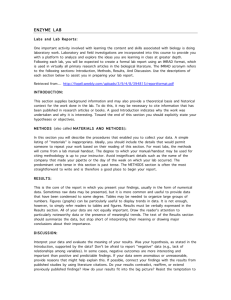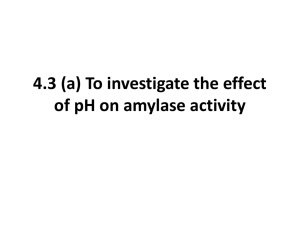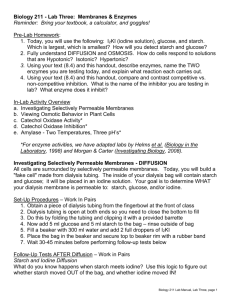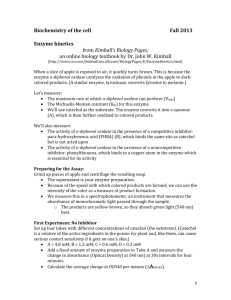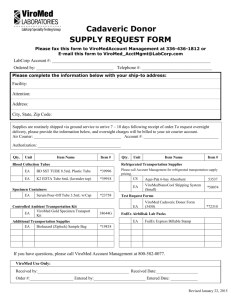Enzyme Functionality Lab Report: Temperature, pH, Inhibitors
advertisement
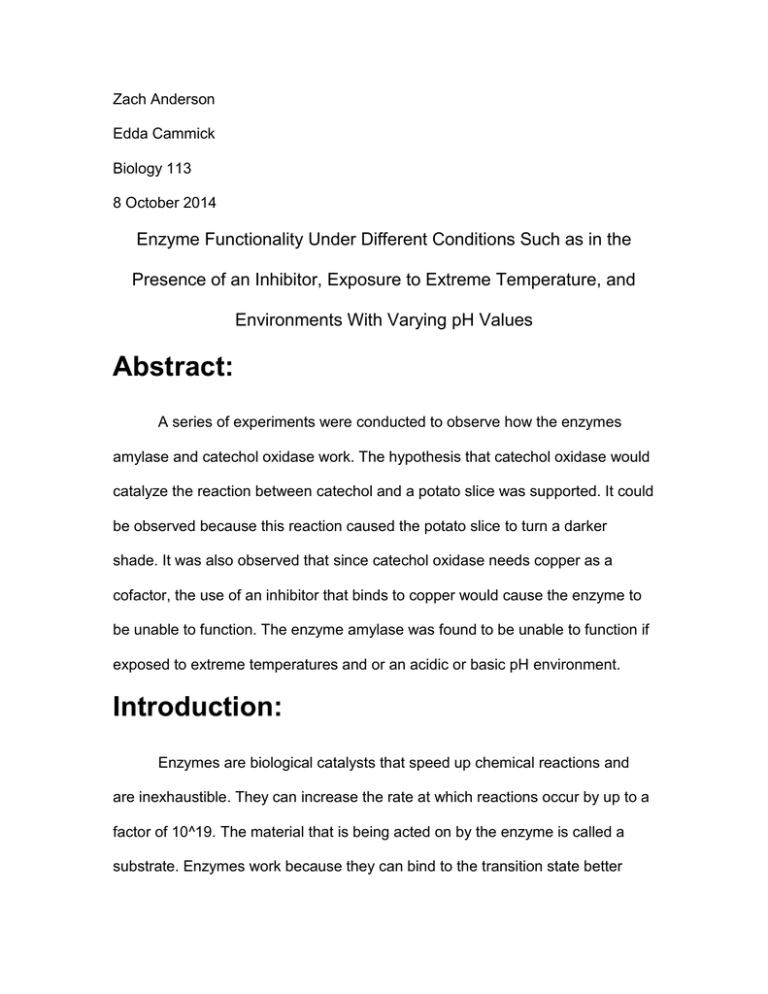
Zach Anderson Edda Cammick Biology 113 8 October 2014 Enzyme Functionality Under Different Conditions Such as in the Presence of an Inhibitor, Exposure to Extreme Temperature, and Environments With Varying pH Values Abstract: A series of experiments were conducted to observe how the enzymes amylase and catechol oxidase work. The hypothesis that catechol oxidase would catalyze the reaction between catechol and a potato slice was supported. It could be observed because this reaction caused the potato slice to turn a darker shade. It was also observed that since catechol oxidase needs copper as a cofactor, the use of an inhibitor that binds to copper would cause the enzyme to be unable to function. The enzyme amylase was found to be unable to function if exposed to extreme temperatures and or an acidic or basic pH environment. Introduction: Enzymes are biological catalysts that speed up chemical reactions and are inexhaustible. They can increase the rate at which reactions occur by up to a factor of 10^19. The material that is being acted on by the enzyme is called a substrate. Enzymes work because they can bind to the transition state better than the substrate, which lowers the activation energy causing the speed of a reaction to accelerate. The enzyme combines with a substrate at the enzymes active site which creates the enzyme substrate complex. This is where catalysis takes place. When the reaction is complete, the complex dissociates. After the complex dissociates the enzyme is unchanged and as a result can move on to catalyze another reaction. Even though enzymes speed up reactions they do not have the ability to determine the direction of the reaction. Enzyme activity can be affected by many external factors including temperature and pH. For the enzyme amylase, which is involved in the breakdown of starch into glucose and is found in the mouths of humans and a few other mammals, the temperature cannot be too hot or too cold or else it will become denatured and cannot function. The same is true of pH. Amylase cannot function if exposed to a pH that is too acidic or basic. The enzyme catechol oxidase in the presence of oxygen catalyzes the removal of electrons and hydrogens from catechol causing it to be converted to benzoquinone, which polymerizes to form catechol melanin. This melanin causes the darkening of fruits and vegetables therefore when catechol oxidase comes into contact with a fruit or vegetable it turns a darker color. To become active catechol oxidase requires copper as a cofactor. This means that it can be turned ineffective if exposed to an inhibitor. The inhibitor phenylthiourea (PTU) commonly combines with copper. If this occurs the enzyme catechol oxidase is rendered useless. Hypothesis: For the following the first sentence is the experimental hypothesis and the second is the null. 4.1) If catechol oxidase is exposed to both catechol and the potato slice then a reaction will occur that turns the potato slice a darker color. If both the potato slice and catechol are not present then the reaction will not occur. 4.2) If catechol oxidase is exposed to the inhibitor PTU in the same concentration then the reaction will not occur. If there is less PTU then catechol oxidase then a reaction will occur. 4.3A) The higher the concentration of amylase the faster a reaction will occur. The lower the concentration of amylase the faster a reaction will occur. 4.3B) If amylase is exposed to an environment where the pH is acidic or basic then a reaction will not occur. If amylase is exposed to an environment where the pH is acidic or basic then a reaction will occur. 4.3C) If amylase is exposed to extreme cold or hot temperatures then it will denature and a reaction will not occur. If amylase is exposed to extreme cold or hot temperatures then it will not denature and a reaction will occur. Materials and Methods: To begin the first experiment three experimental tubes are prepared containing the same total amount of solution. The pipettes cannot be contaminated. After each tube is prepared, a finger was used to hold a Parafilm square securely over the tube mouth. Then the tube was rotated to mix the contents thoroughly. A fresh square was used for each tube. The contents of the tubes are as follows: Tube Distilled Water Catechol Distilled Water Potato Extract 1 5mL 0.5mL 0.5mL ---- 2 5mL 0.5mL ---- 0.5mL 3 5mL ---- 0.5mL 0.5mL The results were recorded after the reactions in the tubes were observed. For the next experiment another three tubes were prepared using the guidelines in the following table: Tube Distilled Potato PTU Distilled Catechol Water Extract 1 5mL 0.5mL 0.5mL 0.5mL 0.5mL 2 5mL 0.5mL 0.5mL ---- 1mL 3 5mL 0.5mL ---- 1mL 0.5mL Water It is important to note that catechol was added to the tubes last. The results were recorded after the reactions in the tubes were observed. For the next experiment an amylase dilution was prepared. 5 standard test tubes were numbered 1-5. Using a 5mL-graduated pipette, 5mL of distilled water were added to each tube. Then several dilutions were made with different concentrations of amylase. Then experimental test tubes were prepared. A second set of 5 test tubes was then numbered 1-5. Beginning with tube 5 of the first set, 2mL of the dilution was transferred into tube 5 of the second set. A 5 mL pipette was used for the transfer. The pipe was then rinsed in distilled water and the procedure was repeated for tubes 4,3,2, and 1. After these transfers test tube set 1 was no longer needed. Then 2mL of pH 6.8 buffer solution was added to each of the tubes in the second set. Then 1-2 drops of I2KI were added to each compartment of four rows of a test plate. The rate at which the each reaction occurred was then recorded. For the next experiment 6 standard test tubes were numbered 1-6 and marked with a pH value of 4, 5, 6,7,8, or 9. Then 5mL of the appropriate buffer was added to each of the tubes. The pipette was rinsed with distilled water after dispensing each buffer. Then 1.5mL of amylase was added to each tube and mixed in. 1 or 2 drops of I2KI were then placed in the compartments of several rows of the test plate. Then using only tube 1, 2.5mL of the 1% starch solution was added. This time was then recorded as 0. A drop of the reaction mixture from tube 1 was then removed and added to a drop of I2KI on the test plate. The reaction mixture was then sampled at 10-second intervals until a blue color was no longer produced. The time it took for the digestion of the starch was then recorded. Then the same process was repeated for the remaining 5 test tubes. For the next experiment, 4 standard test tubes were numbered 1-4. Then using a 5mL-calibrated pipette, 2mL of the 1% starch solution was added to each tube. Next 4 mL of DI water was added to each tube. Then 1 mL of 6.8 buffer was added to each tube. The 4 tubes were then placed as follows: 1) 80 degrees Celsius water bath 2) 37 degrees Celsius water bath 3) Test tube rack 4) Beaker of crushed ice A second set of 4 test tubes were then marked 1A through 4A. Then 1 mL of amylase was added to each tube and placed in the same manner as the first set of tubes respectively. All 8 tubes were then allowed to sit for 10 minutes. Several rows of the test plate were then filled with 1 or 2 drops of I2KI per compartment. Tubes 1 and 1A were then mixed. The mixture was then added to a drop of I2KI on the test plate. The mixture was then added to a new well at 30-second intervals until a blue color was no longer produced and the I2KI solution remained a yellow-amber color. The time it took since the first drop was placed was recorded. The same steps were repeated for each of the other 3 pairs of test tubes. Results: Table 4.1 Test Tube Start Color Finish Color 1 Light yellow/ clear Light yellow/ clear 2 Light yellow/ clear Dark yellow/ clear 3 Clear Clear Test Tube Start Color Finish Color 1 Yellow/ clear Peachy/ clear 2 Yellow/ clear Light green/ clear 3 Yellow/ clear Olive Oil yellow Percent of Amylase (%) Time of Starch Table 4.2 Table 4.3A Disappearance 1 0.50 0 sec 2 0.25 0 sec 3 0.125 0 sec 4 0.063 40 sec 5 0.031 70 sec % of amylase 0.6 0.5 0.4 0.3 % of amylase 0.2 0.1 0 0 0 0 40 70 Table 4.3B Test Tube pH Time of Starch Disappearance 1 4 Termination 2 5 Termination 3 6 6:20 min 4 7 5:00 min 5 8 Termination 6 9 Termination Table 4.3C Test Tube Degrees C Time of Starch Disappearance 1 80 No reaction 2 37 0 min 3 22 0 min 4 4 No reaction Conclusion: In experiment 4.1, the effects of catechol oxidase were observed. The results of the experiment can be found in table 4.1 above. Test tube 2 was the only tube that changed color as a result of the reaction brought on by catechol oxidase. This reaction occurred because the catechol in this tube only because it was the only tube that contained both the potato extract and the catechol. The reason the other tubes did not see a change was because the potato extract and the catechol were not present at the same time. In experiment 4.2, the effects of inhibitors on the enzyme catechol oxidase were observed. The specific inhibitor used was called phenylthiourea (PTU). The PTU inhibits catechol oxidase by combining with copper that is a cofactor for the enzyme. In the first test tube the amount of catechol was the same as the amount of PTU, which resulted in the reaction not taking place at all. Since there was twice as much catechol as PTU in the second tube the reaction was still able to take place only it was slower. In the third tube there was no PTU present, which allowed for the reaction to be completed entirely. In experiment 4.3A the effects of different concentrations of amylase on a reaction were observed. The results presented in table 4.3A show that the higher the concentration of amylase the quicker the reaction took place. In experiment 4.3B the effects of pH on Amylase function were observed. The tubes with the pH’s of 4, 5, 8, and 9 did not show a sign of amylase activity. The tubes with the pH’s of 6 and 7 however showed signs that the amylase was acting on the starch. The tube with pH of 7 is the most neutral and therefore is the optimal pH for amylase to act. In experiment 4.3C the effects of temperature on the function of amylase were observed. When exposed to extreme cold and hot temperatures the amylase denatured and did not react. When exposed to room temperature and at 37 degrees Celsius, the amylase did not denature and was therefore able to react with the starch. Works Cited Garcia-Viloca, M. "How Enzymes Work: Analysis by Modern Rate Theory and Computer Simulations." Science 303.5655 (2004): 186-95. Web. <http://academics.tctc.edu/lynx/enzymes/Garcia-Viloca.pdf>. Guardo, Mario Di, Alice Tadiello, Brian Farneti, Giorgia Lorenz, Domenico Masuero, Urska Vrhovsek, Guglielmo Costa, Riccardo Velasco, and Fabrizio Costa. "A Multidisciplinary Approach Providing New Insight into Fruit Flesh Browning Physiology in Apple (Malus X Domestica Borkh.)." Ed. William Barendse. PLoS ONE 8.10 (2013): E78004. Web. <http://www.ncbi.nlm.nih.gov/pmc/articles/PMC3799748/>. Morgan, Judith Giles., and M. Eloise Brown Carter. Investigating Biology Laboratory Manual. 8th ed. San Francisco: Benjamin Cummings, 2010. Print. Urbany, Claude, Benjamin Stich, Lysann Schmidt, Ludwig Simon, Hergen Berding, Holger Junghans, Karl-Heinz Niehoff, Alexander Braun, Eckhard Tacke, Hans-Rheinhardt Hofferbert, Jens Lübeck, Josef Strahwald, and Christiane Gebhardt. "Association Genetics in Solanum Tuberosum Provides New Insights into Potato Tuber Bruising and Enzymatic Tissue Discoloration." BMC Genomics 12.1 (2011): 7. Web. 8 Oct. 2014. <http://www.ncbi.nlm.nih.gov/pmc/articles/PMC3023753/>. Warshel, Arieh. "Energetics of Enzyme Catalysis." Proceedings of the National Academy of Sciences 75.11 (1978): 5250-254. Web. 8 Oct. 2014. <http://academics.tctc.edu/lynx/enzymes/Warshel.pdf>.
